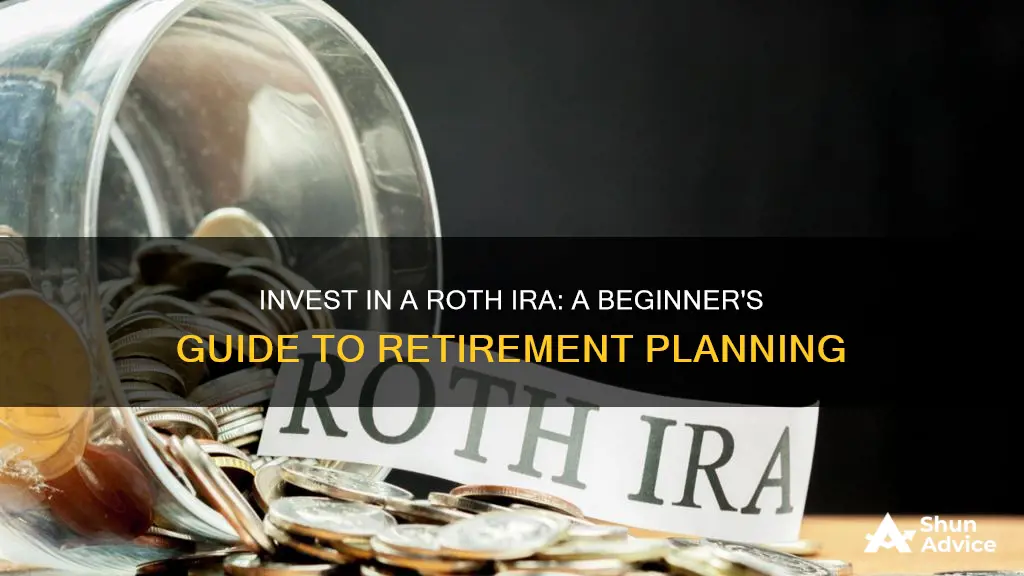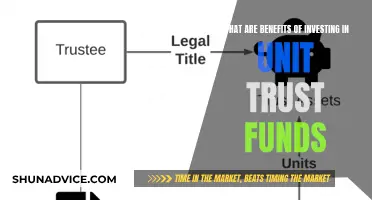
A Roth IRA is a great way to invest for retirement. It allows you to grow your money tax-free and then withdraw it without paying taxes in retirement. You can build up a nest egg that the government will never be able to touch. It's important to take full advantage of this account by maxing out your annual contributions and investing in options with a strong likelihood of growing over the long term.
When choosing investments for your Roth IRA, it's crucial to consider their after-tax returns as these can vary significantly from pre-tax figures. Funds with high-income generation and lower tax efficiency should be prioritized. You'll also want to focus on investments that have strong long-term growth potential but with little chance of decline, steering clear of highly speculative investments.
- S&P 500 index funds
- Dividend stock funds
- Value stock funds
- Nasdaq-100 index funds
- Real estate investment trusts (REITs)
- Target-date funds
- Small-cap stock funds
- Bond funds
| Characteristics | Values |
|---|---|
| Type of account | Individual retirement account |
| Tax treatment | Contributions are made with after-tax money; withdrawals are tax-free |
| Investment options | Stocks, bonds, mutual funds, exchange-traded funds (ETFs), target-date funds, robo-advisors, etc. |
| Eligibility | Most people with earned income are eligible; income limits apply |
| Contribution limits | $7,000 for those under 50; $8,000 for those 50 and older |
| Age restrictions | No age limits; can open an account for a child of any age |
| Custodian | Financial institution that takes custody of your money |
| Fees | May include account opening/maintenance fees, trading fees, expense ratios |
| Risk tolerance | Consider time horizon and ability to tolerate risk when choosing investments |
| Diversification | A mix of stocks, bonds, and other assets can help balance risk and return |
What You'll Learn

Understanding asset allocation
When allocating your assets, it's important to consider your risk tolerance and time horizon. Your risk tolerance refers to how much risk you are comfortable taking on in your investments. If you have a low risk tolerance, you may want to allocate more of your portfolio to less risky assets like bonds and cash. On the other hand, if you have a higher risk tolerance, you may want to allocate more to stocks, which tend to provide higher returns over time but come with greater risk.
Your time horizon refers to how long you plan to invest for. If you are investing for the long term, such as for retirement, you may be able to take on more risk since you have more time to recover from any losses. As you get closer to retirement, you may want to adjust your asset allocation to include more conservative investments like bonds and cash.
It's also important to consider the fees associated with different investments. Index funds and exchange-traded funds (ETFs) are popular options for Roth IRAs because they provide diversification at a relatively low cost. Mutual funds are another option but tend to have higher expense ratios. When choosing investments, be sure to consider the fees in addition to the potential returns and risks.
Robo Advisors: Index Fund Investing Strategies Explored
You may want to see also

Considering your risk tolerance
When investing in a Roth IRA, it's important to consider your risk tolerance, or how much risk you're comfortable with in your investment portfolio. Here are some factors to consider when determining your risk tolerance:
Time Horizon
Your time horizon refers to how long you plan to invest your money. If you're investing for the long term, such as for retirement, you may be able to tolerate more risk in your portfolio. Historically, stocks have tended to provide higher returns over longer periods, but they can also be more volatile in the short term. As you get closer to retirement, you may want to adjust your portfolio by reducing your stock allocation and increasing your allocation to less risky assets, such as bonds.
Ability to Tolerate Risk
It's important to assess your comfort level with risk. If you're investing in the stock market, keep in mind that there will be ups and downs. You should feel confident that short-term fluctuations won't derail your long-term goals. Choosing an investment mix that aligns with your risk tolerance will make you less likely to panic and sell when the market declines, which can help you avoid locking in losses and give your investments time to recover.
Age
Your age can be a factor in determining your risk tolerance. Generally, when you're younger, you may be able to tolerate more risk because you have a longer time horizon to ride out market fluctuations. As you get closer to retirement age, you may want to gradually reduce your stock allocation and increase your bond allocation to preserve your savings. However, it's important to note that even in retirement, growth remains important, as you may need your retirement savings to last for several decades.
Financial Situation
Your financial situation can also impact your risk tolerance. If you're investing for a long-term goal like retirement, you may be able to tolerate more risk compared to a shorter-term goal. Additionally, if your financial outlook seems uncertain, you may want to have a relatively lower allocation to stocks to reduce potential losses.
Rules of Thumb
There are some rules of thumb you can use to estimate your risk tolerance. One common rule is to subtract your age from 100 (or 110 if you're comfortable with more risk). The resulting number can be used as a percentage of your portfolio that should be allocated to stocks. For example, if you're 30 years old, you may allocate 70% to 80% of your portfolio to stocks. Keep in mind that this is just a starting point, and you can adjust it based on your personal circumstances.
Asset Allocation
Your asset allocation, or how your investments are divided among different types of assets, is an important consideration when determining your risk tolerance. Stocks, also known as equities, tend to provide higher returns over the long term but come with higher risk. Bonds and other fixed-income investments are relatively safer and can help balance out the risk in your portfolio. Diversification across different asset classes, market sectors, and geographic regions can also help manage risk.
Professional Guidance
If you're unsure about your risk tolerance or how to allocate your investments, consider seeking guidance from a financial advisor or using a robo-advisor service. These services can help you build a portfolio that aligns with your risk tolerance and investment goals.
Mutual Funds: US Market Investment Options for Indians
You may want to see also

Choosing mutual funds
When choosing mutual funds for your Roth IRA, there are a few key considerations to keep in mind. Here are some detailed instructions on choosing mutual funds for your retirement savings:
Understand Your Risk Tolerance
It's important to consider your tolerance for risk when selecting mutual funds. Generally, stocks come with higher risk and higher potential returns, while bonds are considered safer but offer lower returns. Your risk tolerance depends on factors like your age, investment horizon, and financial goals. Younger investors can typically tolerate more risk, as they have more time to recover from potential losses. As you approach retirement age, it's advisable to shift towards more conservative investments to protect your savings.
Diversification
Diversifying your portfolio across different asset classes, sectors, and geographic regions is crucial for managing risk. Mutual funds themselves are already diversified, as they pool money from multiple investors to invest in a variety of stocks, bonds, or other assets. However, you can further diversify your Roth IRA by investing in multiple mutual funds with different investment strategies, sectors, and geographic focuses. This helps spread out your risk and maximize returns.
Expense Ratios and Fees
When selecting mutual funds, pay close attention to their expense ratios and fees. Expense ratios reflect the annual fees charged by the fund, typically expressed as a percentage of your investment. Look for funds with lower expense ratios, as high fees can eat into your investment returns over time. Additionally, consider the fees charged by the financial institution offering the Roth IRA account. These fees can vary significantly between institutions, so it's important to compare options before deciding.
Investment Strategy
Different mutual funds have different investment strategies, and you should choose funds that align with your financial goals and risk tolerance. For example, growth funds focus on capital appreciation and tend to invest in stocks with strong growth potential. On the other hand, income funds prioritize current income through dividend-paying stocks or interest payments from bonds. There are also specialty funds that focus on specific sectors or types of investments, such as technology stocks or real estate investment trusts (REITs).
Track Record and Performance
While past performance doesn't guarantee future results, it's still important to consider the track record and historical returns of the mutual funds you're considering. Look at the fund's performance over different time periods, especially during market downturns, to get a sense of how it handles different market conditions. Additionally, consider the fund's volatility and how it compares to similar funds in the same category.
Professional Guidance
If you're unsure about selecting mutual funds on your own, consider seeking guidance from a financial advisor or using a robo-advisor service. Financial advisors can provide personalized recommendations based on your financial situation, goals, and risk tolerance. Robo-advisors, on the other hand, use algorithms to build and manage investment portfolios based on your inputs. These services typically have lower fees than traditional financial advisors but may not offer the same level of customization.
Investment Firm Fund Closures: Strategies Behind the Scenes
You may want to see also

Knowing when to seek professional investment advice
- Complexity of Investment Options: Investing in a Roth IRA can be complex, especially if you are new to investing or have limited knowledge about different investment options. If you feel overwhelmed by the range of choices available, such as stocks, bonds, mutual funds, or real estate, it may be beneficial to consult a financial advisor. They can provide guidance on which investment options align with your financial goals, risk tolerance, and time horizon.
- Risk Management: Investing always carries a certain level of risk, and it's important to understand your risk tolerance when investing in a Roth IRA. If you are unsure about assessing and managing risk, seeking advice from a professional can help you make more informed decisions. They can assist in evaluating the potential risks associated with different investments and guide you in constructing a portfolio that matches your risk profile.
- Retirement Planning: Retirement planning is a critical aspect of investing in a Roth IRA. If you are unsure about how to maximize your Roth IRA for retirement, seeking professional advice can be beneficial. Financial advisors can help you create a comprehensive retirement plan, taking into account your current financial situation, long-term goals, and expected expenses during retirement. They can also provide guidance on contribution strategies, tax implications, and withdrawal plans to ensure your retirement savings last throughout your golden years.
- Tax Implications: Understanding the tax implications of your Roth IRA investments is crucial. While Roth IRAs offer tax advantages, the specifics can be complex. A financial advisor can help you navigate the tax rules, ensure you stay compliant, and maximize the tax benefits associated with your Roth IRA. This is especially important if you have multiple income sources or a complex financial situation.
- Ongoing Portfolio Management: Managing your Roth IRA portfolio is an ongoing process that requires regular monitoring and adjustments. If you don't have the time or expertise to actively manage your portfolio, consider seeking professional advice. Financial advisors can provide ongoing portfolio management services, helping you rebalance your investments, adjust your asset allocation as needed, and make strategic decisions to stay on track with your financial goals.
- Significant Life Changes: Life is full of unexpected events, and certain life changes may impact your investment strategies. For example, getting married, having children, changing jobs, or experiencing a health crisis can affect your financial situation and investment priorities. In such cases, consulting a financial advisor can help you navigate these changes and adjust your Roth IRA investments accordingly.
Remember, it's always a good idea to do your own research and educate yourself about investing in a Roth IRA. However, if you feel uncertain or need personalized guidance, don't hesitate to seek professional investment advice. Working with a qualified financial advisor can provide you with valuable insights, help you make more informed decisions, and ultimately improve your chances of achieving your financial goals.
Mutual Funds: Risky Business and Why You Should Avoid
You may want to see also

Selecting stocks and bonds
When selecting stocks and bonds to invest in your Roth IRA, it's important to consider your risk tolerance, time horizon, and financial goals. Here are some tips to help you choose the right stocks and bonds for your Roth IRA:
Understand Your Risk Tolerance:
Consider how comfortable you are with taking risks. If you're closer to retirement or have a lower risk tolerance, you may want to allocate more of your portfolio to bonds or less volatile stocks. On the other hand, if you're younger or have a higher risk appetite, you may tilt your portfolio towards stocks with higher growth potential.
Diversify Your Investments:
Diversification is a key strategy to manage risk and maximize returns. Invest in a variety of stocks and bonds from different sectors, industries, and geographic regions. You can invest in individual stocks and bonds or choose mutual funds or exchange-traded funds (ETFs) that provide exposure to a diverse range of companies and industries.
Consider Your Time Horizon:
Your investment horizon, or how long you plan to invest for, is an important factor in determining your asset allocation. If you're investing for the long term, you may be able to take on more risk and allocate more towards stocks. As you get closer to retirement, you may want to gradually reduce your stock allocation and increase your bond holdings to preserve capital and generate stable income.
Evaluate Different Types of Stocks and Bonds:
There are various types of stocks and bonds to choose from. Here are some options to consider:
- Broad-based U.S. Stock Index Funds: These funds track a broad stock market index, such as the S&P 500, and provide exposure to a diverse range of large-cap U.S. companies. They offer low-cost diversification and have historically performed well over time.
- Dividend Stock Funds: These funds invest in companies that pay regular dividends to shareholders. Dividend stocks are often found in mature industries and tend to be less volatile, making them attractive for investors seeking income and stability.
- Value Stock Funds: These funds invest in stocks that are considered undervalued relative to their intrinsic worth or the broader market. Value stocks may offer higher returns over time and are typically less volatile, making them suitable for long-term investment in a Roth IRA.
- U.S. Bond Index Funds: Bond funds provide stable income and reduce the overall risk of your portfolio. A broad-based U.S. bond index fund offers exposure to a diverse range of high-quality bonds, including Treasuries and corporate bonds, at a low cost.
- Global Stock Index Funds: Adding international stocks to your portfolio can provide further diversification and exposure to the global economy. Global stock index funds invest in a broad selection of non-U.S. stocks, reducing your dependence on the performance of the U.S. market alone.
Remember, it's important to do your own research and consult with a financial advisor to determine the best stocks and bonds for your specific situation and financial goals.
Super Funds: Where Your Money is Invested
You may want to see also
Frequently asked questions
A Roth IRA is a type of tax-advantaged individual retirement account that should be invested in with a long-term perspective in mind. It's important to choose investments that match your risk tolerance, investment timeframe, and financial situation. A common strategy is to invest in a diversified portfolio of stocks, bonds, and other assets, taking into account your age, risk tolerance, and financial goals.
You can hold a variety of investments in a Roth IRA, including individual stocks, bonds, mutual funds, exchange-traded funds (ETFs), and target-date funds. It's important to consider the fees, investment choices, and customer support offered by the financial institution you choose to open your Roth IRA with.
When choosing investments for your Roth IRA, it's important to consider your risk tolerance, investment horizon, and financial goals. You can choose to design your own investment portfolio or consult a financial advisor to help you pick investments that align with your goals. Diversification is key to reducing risk and maximizing returns over the long term.







